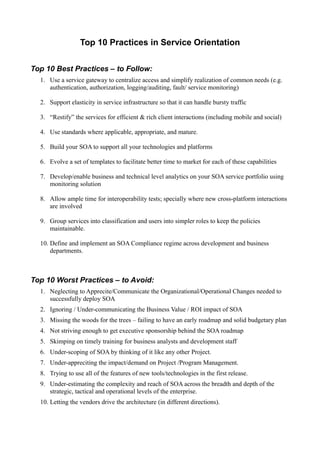Top 10 soa practices to follow and avoid
- 1. Top 10 Practices in Service Orientation Top 10 Best Practices ŌĆō to Follow: 1. Use a service gateway to centralize access and simplify realization of common needs (e.g. authentication, authorization, logging/auditing, fault/ service monitoring) 2. Support elasticity in service infrastructure so that it can handle bursty traffic 3. ŌĆ£RestifyŌĆØ the services for efficient & rich client interactions (including mobile and social) 4. Use standards where applicable, appropriate, and mature. 5. Build your SOA to support all your technologies and platforms 6. Evolve a set of templates to facilitate better time to market for each of these capabilities 7. Develop/enable business and technical level analytics on your SOA service portfolio using monitoring solution 8. Allow ample time for interoperability tests; specially where new cross-platform interactions are involved 9. Group services into classification and users into simpler roles to keep the policies maintainable. 10. Define and implement an SOA Compliance regime across development and business departments. Top 10 Worst Practices ŌĆō to Avoid: 1. Neglecting to Apprecite/Communicate the Organizational/Operational Changes needed to successfully deploy SOA 2. Ignoring / Under-communicating the Business Value / ROI impact of SOA 3. Missing the woods for the trees ŌĆō failing to have an early roadmap and solid budgetary plan 4. Not striving enough to get executive sponsorship behind the SOA roadmap 5. Skimping on timely training for business analysts and development staff 6. Under-scoping of SOA by thinking of it like any other Project. 7. Under-appreciting the impact/demand on Project /Program Management. 8. Trying to use all of the features of new tools/technologies in the first release. 9. Under-estimating the complexity and reach of SOA across the breadth and depth of the strategic, tactical and operational levels of the enterprise. 10. Letting the vendors drive the architecture (in different directions).

